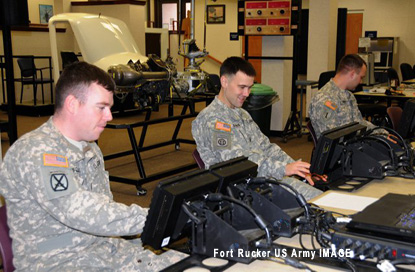FORT RUCKER, Ala. -- The Aviation Learning Center on Fort Rucker received four new Cockpit Academic Procedural Trainers to help flight students and transitioning Aviators stay proficient Jan. 9.
The learning center received two of each of the UH-60M Black Hawk and the CH-47F Chinook cockpit trainers to help Fort Rucker flight students, said Capt. Jared K. Koelling, assistant U.S. Army Training and Doctrine Command capability manager.
"These devices were installed in the learning center in order to benefit the students and Aviators learning to fly these aircraft," said Koelling. "Basically these devices allow anybody from initial-entry flight students to Aviators that are transitioning from the older UH-60 Alpha/Lima and CH-47 Delta models."
The cockpit trainers can also be used for sustainment training, according to the captain.
![]()
-W01 Harry Thomas, W01 Jon Szopinski, and W01 Ben Stoddart, all of B Company, 1st Battalion, 145th Aviation Regiment, get familiar with the new Cockpit Academic Procedural Trainers that are available to flight students and Aviators at the Aviation Learning Center Jan. 17., Fort Rucker US Army Image-
The fact that the CAPTs are available to Aviators on their own time is a big advantage to having these in the learning center, according to George Snyder, instructor at the Aviation Learning Center.
"The flight line and the academic side are all structured and very limited by their time," said Snyder, "whereas here, students can come in during their spare time and take as much time as they need to learn what they need to understand about operating the aircraft."
"The flight students have to plan out their missions and with the CAPTs, they can see an actual map on the multi-functional displays and see where their aircraft is flying in the local area," said Snyder. "You don't get that kind of interaction in a classroom or reading it out of a book."
The CAPTs are expensive pieces of equipment -- costing around $82,000 each -- but according to Jill Redington, chief of the U.S Army Aviation Technical Library and the Aviation Learning Center, they practically pay for themselves.
"When you think of the amount of flight students that come through the learning center -- which last year was between 150,000 to 170,000 students -- these devices cost pennies per person to operate," she said. "Compared to the cost of having to run actual aircraft to train, these machines pay for themselves. FMI: Nathan Pfau article
The learning center received two of each of the UH-60M Black Hawk and the CH-47F Chinook cockpit trainers to help Fort Rucker flight students, said Capt. Jared K. Koelling, assistant U.S. Army Training and Doctrine Command capability manager.
"These devices were installed in the learning center in order to benefit the students and Aviators learning to fly these aircraft," said Koelling. "Basically these devices allow anybody from initial-entry flight students to Aviators that are transitioning from the older UH-60 Alpha/Lima and CH-47 Delta models."
The cockpit trainers can also be used for sustainment training, according to the captain.

-W01 Harry Thomas, W01 Jon Szopinski, and W01 Ben Stoddart, all of B Company, 1st Battalion, 145th Aviation Regiment, get familiar with the new Cockpit Academic Procedural Trainers that are available to flight students and Aviators at the Aviation Learning Center Jan. 17., Fort Rucker US Army Image-
The fact that the CAPTs are available to Aviators on their own time is a big advantage to having these in the learning center, according to George Snyder, instructor at the Aviation Learning Center.
"The flight line and the academic side are all structured and very limited by their time," said Snyder, "whereas here, students can come in during their spare time and take as much time as they need to learn what they need to understand about operating the aircraft."
"The flight students have to plan out their missions and with the CAPTs, they can see an actual map on the multi-functional displays and see where their aircraft is flying in the local area," said Snyder. "You don't get that kind of interaction in a classroom or reading it out of a book."
The CAPTs are expensive pieces of equipment -- costing around $82,000 each -- but according to Jill Redington, chief of the U.S Army Aviation Technical Library and the Aviation Learning Center, they practically pay for themselves.
"When you think of the amount of flight students that come through the learning center -- which last year was between 150,000 to 170,000 students -- these devices cost pennies per person to operate," she said. "Compared to the cost of having to run actual aircraft to train, these machines pay for themselves. FMI: Nathan Pfau article